As a fresh Indian MBA graduate with no exposure to International exchange program, one of the things I noticed in my first foreign business trip was the concept of networking lunches - where meeting people from different teams or companies for lunch/coffee is the norm. A sharp contrast to the culture in India (in the pre-covid era), where most office-goers would generally head out to the cafeteria with their teams/colleagues for lunch and bond over politics, sports, or cinema. While this helps in cementing the bond we share with our colleagues who become friends over a period of time, I envied the culture in the West where it is still relatively easy to expand your professional network beyond the universities and companies that you have been associated with. You might mention leveraging LinkedIn but as I explain later, it is more of a recruiting platform than a networking one. So, when I came across news of Lunchclub’s $4 million of seed fundraise from a16z last September, I immediately wished for the platform to launch in India. And it did, in June this year.
In this article, I discuss
Is LinkedIn a networking platform?
How do the new-age networking platforms function?
Lunchclub - Networking with the help of AI
Grab Chai - Virtual coffees in pandemic times
Is there a market for networking platforms?
What the potential TAM could look like?
My feature asks
Is LinkedIn a networking platform?
In its Series B pitch to investors, LinkedIn was framed as “professional people search 2.0”, a signal to the value of Google’s search engine. The founding team expected recruiting to be the initial business opportunity for the platform but deals & networking was another service that they were targeting. With investors focused on revenue generation in 2004, the company highlighted 3 products in its pitch - listings, subscriptions, and ads. However, in 2004, few investors believed subscriptions would work as they viewed the internet largely as an advertising medium. Following the launch of the three revenue products in 2005, the team discovered that recruiting had become its largest market instead of business development & networking.
A decade later, the platform could still be considered largely as a recruitment marketplace, going by the proportion of revenues it made from Talent and marketing solutions in recent years. Prior to its acquisition by Microsoft in 2016, 65% of LinkedIn’s revenues came from Talent solutions (for recruiters), 18% from Marketing solutions (advertising for companies), and only 17% from Premium subscriptions (for access to InMails, greater search results, etc).
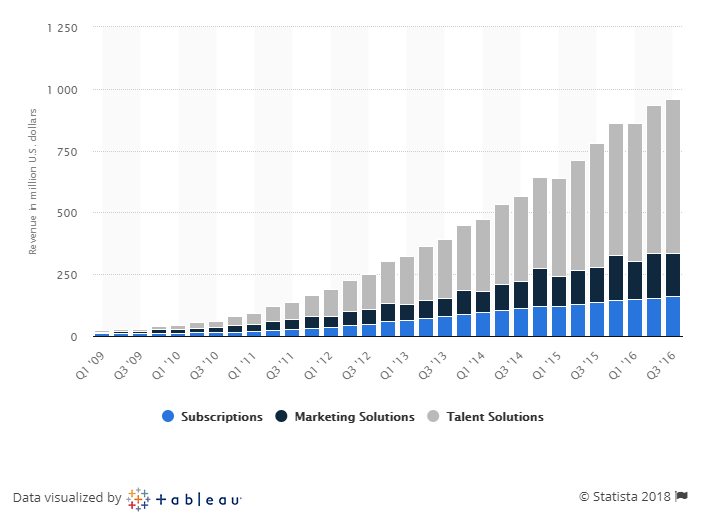
Even when it comes to making connections on the platform, recruiting/exploring job opportunities seems to be the key goal which is reflected in the average number of connections people from different industries had in their network. As per April 2017 data, Staffing & recruiting and Human Resources had the most connections.
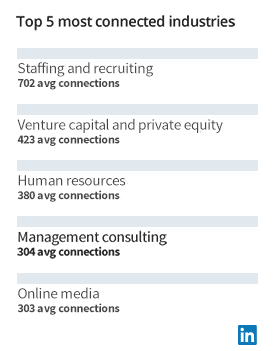
Additionally, LinkedIn seems more like a system storing records of professional achievements that are helpful for sourcing. Connections on LinkedIn are largely likely to be part of your existing network cycle with new connection invites often involving a more of a recruiting angle than that of a networking one. The recommendation engine to add people to your network seems to be too broad-based with little relevance.
Despite Microsoft’s $26 billion of acquisition of LinkedIn and a customer base surpassing 500 million, lack of platform innovation is holding back the latter from becoming a smart networking tool. It has still not solved the common problem for experienced professionals receiving tons of unfamiliar connection requests. Some of such invites that are unaccepted/rejected could be the cause of big missed business opportunities. Categorizing your first-degree connections on the platform into different groups based on your familiarity levels or how regularly you want to be in contact with, hasn’t been developed into a feature yet.
The above friction points have created a white space for people who want to maintain a curated professional network for themselves.
How do new-age networking platforms function?
Newer age platforms like Lunchclub and Grabchai are aiming to transform the way we network and helping us build a well-curated network.
1. Lunchclub - Networking with the help of AI
“However, the innovations of the Internet, big data, and machine learning have mostly led to a record of who you already know and ways to consume relevant content online. Someone who wants to meet relevant people and grow their network has pretty much the same options as existed 50 years ago: conferences, classes, introductions by mutual connectors. “ - Vladimir Novakovski, Co-founder of Lunchclub
Platform description: Lunchclub was founded with the mission of leveraging artificial intelligence to make direct offline connections among people with mutual relevance but may not be part of the same network. Users are asked questions on their interests, objectives, and links of public profiles (LinkedIn, Twitter, blogs, etc, in case they are open to sharing) in their onboarding survey. Based on this, the algorithms use the private data in addition to scraping of the public data available of the users for a better signal. On opting for the weekly meetings, users who get matched for an interaction receive an introductory email. Lunchclub believes that in-person meetings greatly enhance the quality of interaction and hence in the pre-covid, users had to choose a time slot and neighbourhood on the platform where they would be available for meeting their newly introduced connections. Following the meeting, users are asked to rate their interactions which helps in training the algorithms for future matches. Additionally, users have an option to click on ‘Relevant to me’ button when they view a few profiles on the platform, which should be factored in the matching process. User testimonials on the website suggest that people in the US have been able to connect with investors, find perfect hires for their teams and advisors for their startups through the platform. Amid the current shelter-in-place measures, the company now connects people through 1:1 video calls and also hosts fireside chats with entrepreneurs/investors on its platform.
My views: The platform technology also offers its users from under-represented communities a chance to gain access to networks that might have been difficult to obtain, otherwise. For instance, a non-IIT/IIM founder in India might get more opportunities to pitch to investors through Lunchclub, which may not be easy via other sources owing to a lack of mutual connectors. Matches made on the platform go beyond the educational institutes & organizations that a person is associated with, thereby giving him a chance to showcase real expertise in his networking meetings than brands on his resume. By asking the users to clarify their objectives to be on the platform, be it - brainstorming with peers, exploring other companies, or meet interesting people, the technology has the information to filter out irrelevant matches. Apart from interests, incorporating verifiable skillsets in the matching process would be a great way to connect with people possessing certain expertise. While I love the fireside chats that are currently hosted with investors/founders/tech employees from the US, I hope to see this expand to folks from different industries/countries to hear diverse perspectives, as the platform scales.
2. In India, we prefer to Grab Chai
Platform description: Grab Chai is a side-hustle project by Aditya Mohanty and Suhaas Motwani, launched in March 2020, helping people meet interesting folks (for casual or professional catch-up) over the internet either through 1:1 or via group chats. The initiative was launched for people missing water-cooler conversations (or chai-sutta breaks) as they stay-at-home amid the pandemic and would like to gain a chai-buddy with whom they can discuss anything under the sun. New users are asked to fill in a Google form their interests, the industry they are working in, links of their LinkedIn/Twitter account, preferences with respect to casual/professional meeting, and an option to meet someone who is like-minded or “surprise me”.
Founder talk: With promotional activity solely on Twitter, there have been 1500+ signups overall. Every week sees 100-200 users sign up and 30-40% of repeat users for another Grab Chai session. Even as the Grab Chai founders look to automate the process further (currently ~20%), the manual curation results in high quality of connections helped by mutual areas of interest/background among the pairs/groups reflected in the data that gets captured in the Google form. Though 60-70% of users choose the ‘surprise me’ option, the pairs/groups being matched have at least some common area between them so as to minimize awkward silences in their interactions. When no relevant matches are found for certain users, the latter are encouraged to sign up next time, instead of being set up with a mismatched connection. Considering the early stage of the project, the customer base is fairly diverse with 30-40% of users coming from non-tech backgrounds.
While the founders are aware of the comparisons with Lunchclub post the latter’s launch in June, they are currently focused on maintaining the high-quality interactions for its users that is more feasible with manual curation, minimizing ghosting, diversifying its user base before getting into full-blown marketing and scaling up its user base. Simultaneously, they are working on getting a beta version and adding more features on the dashboard. On monetization, the founders mentioned that they would like to see their project economically viable after it reaches a certain scale. The duo is tinkering with ideas of having Clubhouse features (a group chat involving a panel of experts that could be heard by others) and layering Grab Chai on top of an offline layer as a monetization strategy (eg: tie-ups with cafes/restaurants for offline meetings).
My views: Personally, I was surprised to be paired with people who had similar interests as mine and we ended up having delightful chats about our fields and consumer tech. Going by the #Grabchai on Twitter, there seems to have been some wonderful interactions between people helped by the initiative, pasted below is one great example of the kind of future collaborations we could see between high-quality matches made on networking platforms.

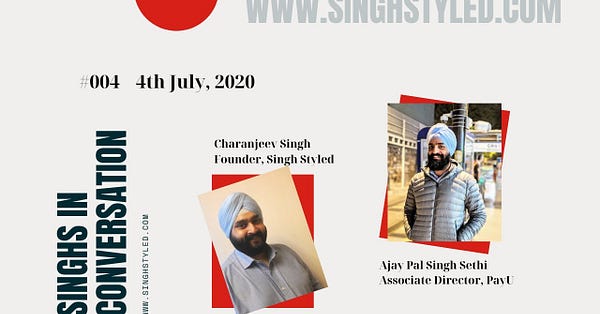
Is there a market for networking platforms?
One of my favourite pieces of advice from my strategy professor was- “Every weekend, meet someone from a different industry for lunch.” While I understood how these networking lunches could help in gaining a better understanding of an industry and broaden one’s perspective, I could barely act on his advice. Reasons being - hesitancy in approaching someone (you don’t know well enough) for a catch-up, not wanting to waste a senior’s time, and the lack of alum connections from different industries, especially when your college focuses on a certain specialization. The Indian education system is to be partly blamed for the lack of networking skills in its students by mollycoddling the latter through campus placements which puts the onus on institutions to find jobs for its students. This culture is very different from other countries where students are encouraged to attend career fairs and networking meetings to understand more about the roles they would be interested in taking up.
A shot at an interview is easy when you can get a referral from an employee in the company, much easier when the hiring manager remembers your profile from a previous interaction. For an investor, a strong network facilitates access to high-quality deal flow, while for an early-stage founder, network plays a crucial role in starting up with the right team and getting good mentors. Thus, career trajectories are shaped by the invisible hand of networking. Yet, it seems archaic that in this age of a digitally connected world, someone is bereft of key opportunities because he/she doesn’t have access to a particular network.
Platforms like LunchClub and Grab Chai have the potential to democratize access to networks and ease the friction points over a period of time. To capture a sizeable customer base who would be ready to pay to use the platform, there needs to be a mix of both one-sided marketplaces (for eg: students/freshers getting opportunities to interact with potential mentors) and two-sided marketplace (where both matches stand to gain from the interactions). Currently, a user of Lunchclub needs to use 30 clubpoints in case he wants to connect with an expert/founder/investor while no points get spent in case he chooses to connect with a Lunchclub’s pick. We could see a similar strategy adopted even as a revenue model to balance the customer experience across all its users. Pay (or a higher fee), in case you want to connect with an expert or opt for premium packages in case you are looking to close professional transactions via such interactions (for eg. funding deals). Experts could be incentivized (say profile badges) to choose a balance between potential knowledge sharing/advisory meetings and value gain interactions.
Vladimir believes that if Lunchclub reaches the scale of LinkedIn in 5-10 years, both the companies would still be competing, indirectly the way Facebook & Google does. However, while reaching that level, networking apps will do well by avoiding the mistakes that LinkedIn made by ensuring a fine balance between user growth and user experience. Screening out fake profiles, having users with genuine intent towards networking, minimizing ghosting during interactions are some key challenges that such platforms need to work on during the scaling-up process. If the expansion of your network was the dominant theme across consumer media apps from the 2000-2010 era (Facebook, Twitter, or even LinkedIn), with customer experience being impacted by the signal-to-noise ratio in their media feed (a byproduct of the ‘ok to add anyone with whom you have something in common’), the coming years are likely to see platforms that offer its users a high quality of connections via tightly-knit communities, getting popular. We could see consumers preferring an online rodolex of meaningful connections with opportunistic relevance, rather than getting connection requests from anyone and everyone.

What does the potential TAM look like?
Lunchclub sees a potential TAM of $1 billion+. While the platform doesn’t monetize via subscriptions currently, a back-of-the-envelope calculation suggests that an assumption of $10/month in subscription fees for using the platform implies ~8mn users for the company. Not a direct comparison but the average paid subscribers for Match Group, which operates several dating platforms, was ~9mn in 2019 with an average monthly ARPU of $18. It generated revenues of ~$2 billion in 2019 and is trading at 12-month forward EV/Sales of 11x. Gartner expects online dating platforms to cross $9 billion in revenue by 2025. Considering the utility of a professional network over one’s career span (typically between the age of 20-60), the TAM for such platforms is likely to be higher than that of dating services whose demographics are skewed heavily towards 30 & below.
To calculate the potential TAM in India, I relied on Income Tax Department’s data on salary ranges in India (Link: ITR for AY 2018-19). Out of the 40 million+ people in India who file taxes, only 4 million earned more than Rs 10 lakhs as per data released for 2018-19. I consider this category as potential paid users of professional networking sites and exclude college students from the paid user category assuming their lower propensity to pay for a networking platform in their initial stages of using it and also considering the campus placement scene. However, as trends change with students drifting towards working on their own startup’s ideas/side projects, we could see them pay to use the platform for seeking mentors or finding like-minded folks for collaboration on interesting projects. This dataset also excludes individuals who run their own businesses and haven’t filed taxes. While networking is equally important to them, they are likely to be later stage users.
Revenue model: Lunchclub currently uses Clubpoints to incentivize its users for referrals and for attending meetings. Revenue models in the future could be based on either monthly subscription fees, pay for every meeting, or fees charged for use of additional features (for eg: seeking more curation wrt profile match, etc.). The risks for pay per meeting model could be users meeting off-platform post their introduction through the service.
Few scenarios I have considered for TAM calculation in India:
a) As per the (conservative) assumptions made in the table below, we could see a potential serviceable address market (SAM) of at least $30 million or Rs 225 crores in India for professional networking platforms. It needs to be noted that LinkedIn has 62 million users in India, the second-largest market after the US, so the actual potential user base is larger than the 4 million I have assumed for SAM calculation.
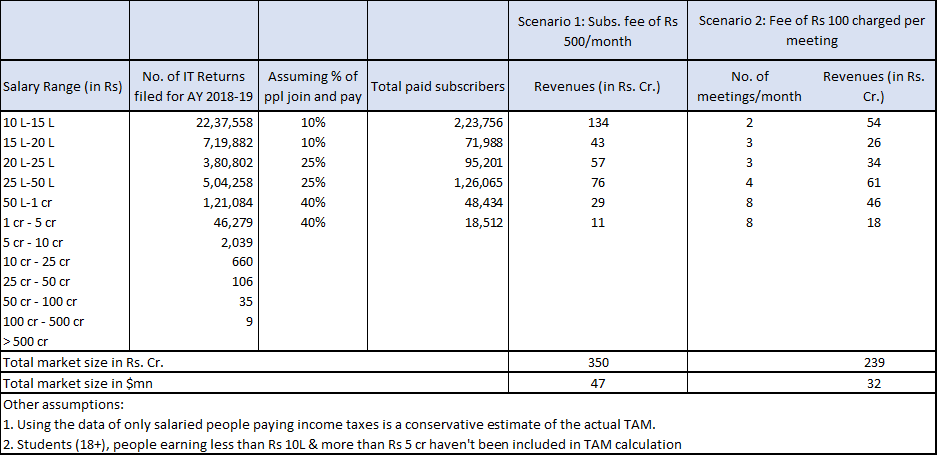
b) If we assume that all 4 million people who earn more than Rs 10 lakhs annually (& filing taxes) are potential paid users, a yearly subscription fee of Rs 6,000 could imply a market size of $320 million.
c) There were 8.5 million people earning between Rs 5.5 lakhs - Rs 10 lakhs annually, representing an additional potential market of $680 million to Scenario b).
d) Roughly 37.4 million Indian students were enrolled in higher education in 2018-19 out of which 1 million were pursuing MBA & engineering. Assuming all these students were to purchase even 1 month’s subscription plan of Rs 500, there could be an additional revenue contribution of ~$270 million.
Combining the figures from b) to d), we could see a total TAM of $1.3 billion in India for professional networking platforms.
Would users pay for a networking platform when they don’t subscribe to LinkedIn Premium solutions? Despite the steep price, the latter doesn’t really guarantee a meeting set-up with the person you want to message, a contrast to the bottom of the funnel approach of the newer age networking services. As adoption of these platforms increase, the fear of missing out on opportunities that peers might gain through these services will trigger strong network effects.
My feature asks from such platforms:
I would love to use (and pay) for a networking platform that:
Has a diverse global user base to gain different perspectives from the connections made
Makes it easier to connect 1:1 with profiles possessing certain expertise.
Gets better at matching based on my feedback of previous interactions - algorithm models understanding the kind of profiles I connect with better
Help discover experts who are willing to be potential mentors or career sponsors.
Section for personal note-taking on the platform about each interaction that took place. For eg: anecdotes, anything the match is searching for, recommendations, etc
Conclusion
With shelter-in-place measures implemented across regions and companies allowing people to work from home wherever possible, we would see people increasingly preferring to network online. It remains to be seen though if new-age professional networking apps could bring about similar changes in the way people change their jobs/strike new deals/collaborate on projects, the way online dating has changed how couples meet in the US (as shown below).
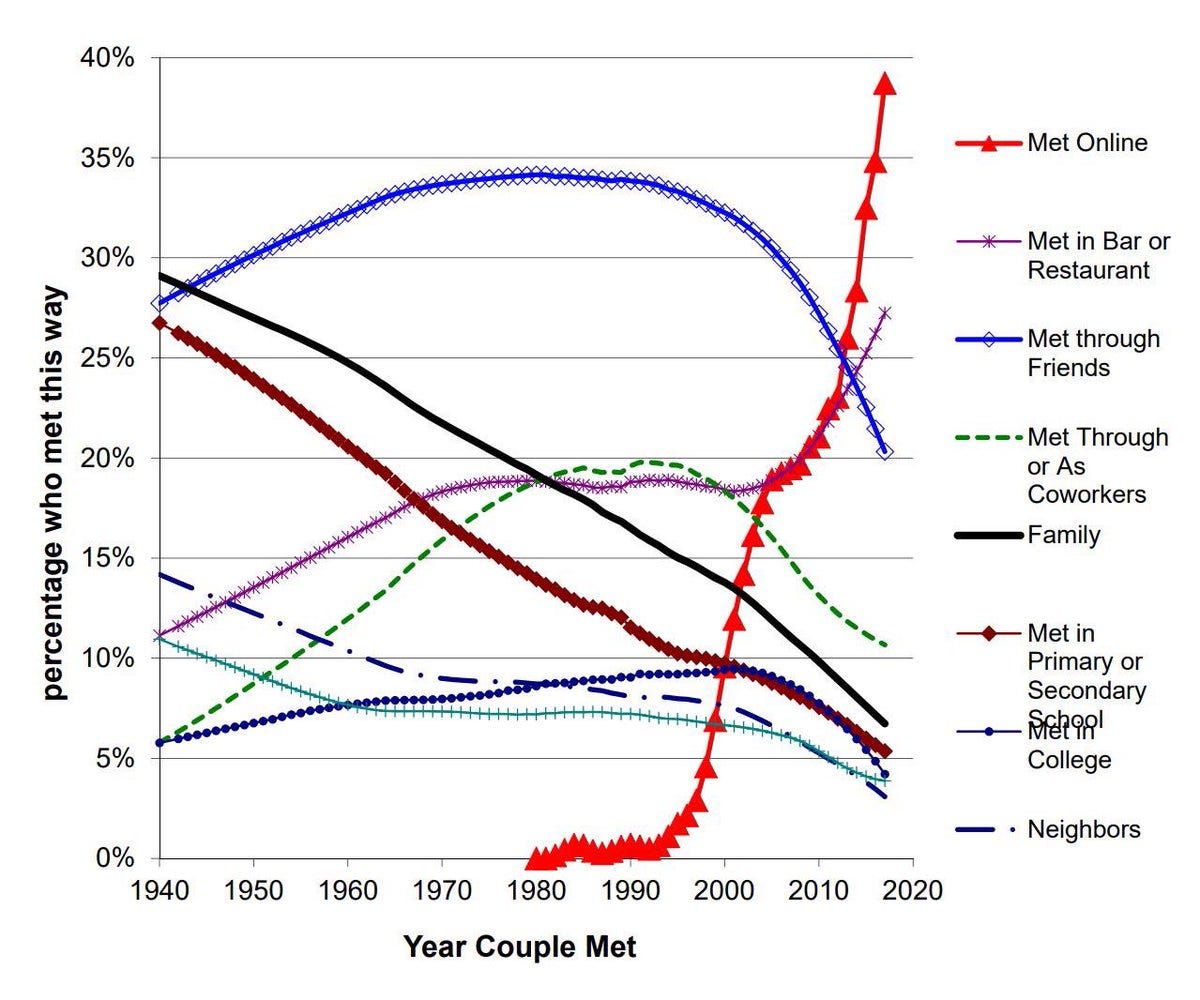
Appendix:
Profiles of Co-founders/founders


